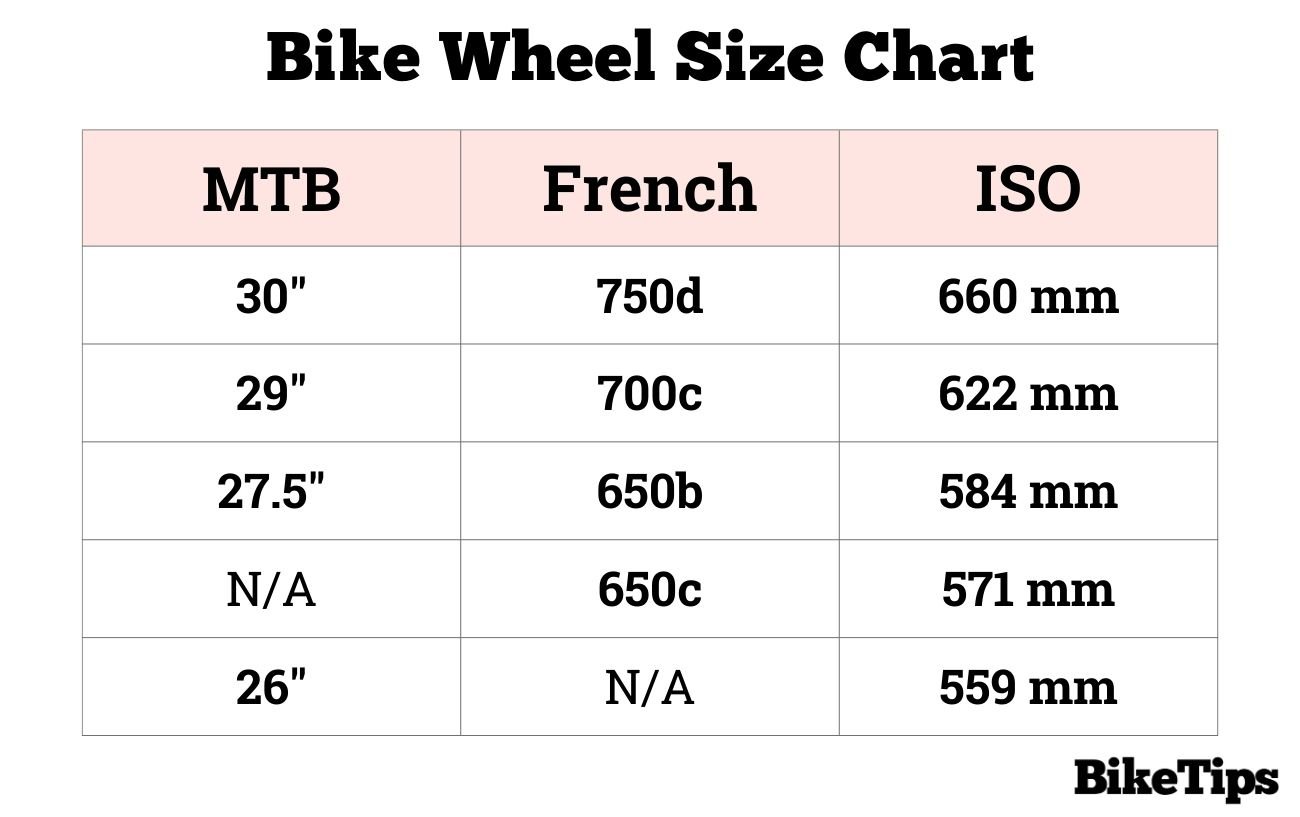Cycling technology is always advancing and companies continue to reinvent the bike to make it faster, more comfortable, and handle better.
In recent years, we have seen a lot of changes, but when a company said they planned to make a new 750d wheel size, it excited us!
This takes them beyond the current largest standard wheel size for bikes, the time-honored 700c (equivalent to 29″ MTB wheels), and and goes well beyond the 650b size often used for gravel bikes and many mountain bikes.
A new wheel size doesn’t just mean that you have another option. It could mean new tires and bikes and, on the right course, offer a huge advantage over your competition.
In general, larger bike wheels offer advantages such as increased momentum, smoother rolling over obstacles, enhanced stability, and better overall efficiency. It was only a matter of time before bike designers logically pushed those advantages one step further.
The downsides of larger wheels are increased weight, affecting acceleration, and a decrease in agility.
The big question is, do we really need to go bigger?
In this article, we’re going to tell you everything you need to know by breaking down wheel sizes and telling you what you can expect to gain from going to 750d. We will discuss:
Where Did The 750d Wheel Size Come From?
750d wasn’t just a passing idea from someone in a bike shop.
It had a lot of research and one of the biggest brands behind it, WTB, short for Wilderness Trail Bikes. It wasn’t just them who loved the idea. They combined forces with the famous titanium bike brand Moots.
It’s a size designed for gravel riding, and WTB and Moots feel that it will offer a better gravel riding experience and is just what gravel cycling needs. Years ago, we had a similar situation with mountain bikes when the 29” wheel was brought to market.
In the ISO standardization of wheel sizing, 750d wheels have a 660 mm bead seat diameter, meaning they’re the same step up in size from 700c (622 mm) as 700c is from 650b (584 mm).
The Different Sizes Of Gravel Bike Wheels

Before we get into telling you about the 750d wheels, it’s good to understand the different sizes of wheels and what they offer so you can truly understand the 750d. Here are the sizes we currently have.
700c Gravel Bike Wheels
700c came from road biking and is also the same bead seat diameter as the mountain bike’s 29-inch wheel. 700c wheels generally have less width to fit narrower tires. It’s also the most common size you’ll find on a gravel bike.
700c wheels are fantastic as they have the ability to hold higher speeds with less effort and have the ability to roll over objects much better than a smaller wheel. They are fast and fun, and you have lots to choose from when it comes to tire choices.
650b Gravel Bike Wheels
Then we have 650b, which is the smaller size of a gravel bike wheel. It has the same bead seat diameter as a 27.5” mountain bike wheel. A lot of gravel riders opt for 650b wheels if they plan on doing a lot of off-road riding.
650b wheels being smaller can accommodate wider tire options on a given bike frame. They also offer a more agile feel and are much better at going around obstacles compared to a larger 700c wheelset. You will also find they accelerate faster than a larger wheel.
The Advantages And Disadvantages Of A 750d Wheel Size
When it comes to riding a 750d wheel, you are going to get some amazing advantages and disadvantages. Here’s what we expect you are going to find.
Advantages of the 750d Wheel Size
Let’s start with the advantages. Obviously, getting hold of a 750d bike and wheel is pretty much impossible currently as the technology is so new, but here’s what we would expect to happen if you were to be using a set on a bike.
Better Rolling Ability
Just like with a 700c compared to a 650b wheel, the larger, the better the ability to roll over objects. A larger 750d wheel will be able to do this further, and with gravel riding not generally hugely technical terrain, it could work very well.
Easier To Hold High Speeds
A larger wheel has a much better ability to hold a higher speed. There are a lot of factors that govern this. Racing bikes will use larger wheels because they can hold momentum much better than smaller wheels.
Increased Contact Patch
When it comes to riding off-road and grip being a big part of that, you sometimes need all you can get. The contact patch on a smaller wheel with a larger tire is lesser than a larger wheel with a smaller tire. A 750d will offer a substantial contact patch for the rider.
Improved Stability
With a larger wheel in a normal bike, you will find that there’s a strong chance the bike will be longer and the wheels pushed further apart from the rider. This could lead to a longer wheelbase and much more stability.
Great For Taller Riders
Taller riders welcome a larger wheel size. This means they can get better geometry, and it will offer more bike options to suit people who are 6 feet and taller, which will be more tailored to them.
Disadvantages of the 750d Wheel Size
Now for the disadvantages, and there are a few more than you might think. We appreciate that these come down to it being new technology more than anything else.
Heavier Wheel
A larger wheel is going to be heavier than a smaller wheel. You have more material, a bigger tire in diameter and also you will need a bigger inner tube or more sealant. It won’t be by a huge amount, but we’re cyclists to many of us it matters.
Not Very Agile
Smaller wheels are generally much more agile compared to larger wheels. The 750d will likely feel hard work on technical ground. Going around objects could be more challenging compared to a smaller 650b wheelset.
Slower Acceleration
A larger wheel is not only heavier, but it’s going to be slower on acceleration. Although at higher speeds, you can hold momentum better, getting up to that speed is going to be more challenging compared to a smaller 650b wheel with a similarly sized tire.
Limited Choices
With a new wheel size comes a very limited range of tire and wheel options. Currently, it’s just WTB who has made a prototype, and we are not seeing a huge amount of other companies currently going down this route. Spares could be a nightmare to find.
You Would Probably Need A New Bike
If you had a 700c gravel bike and dropped to a 650b, then with the wheel being smaller, it won’t cause any issues, as many gravel bikes offer this capability (provided you have disc brakes).
If you want to increase the wheel size from 700c to 750d, then there’s a strong chance you will need a new frame.
It Will Have An Effect On The Gearing
You will also find that a 750d wheel is going to have an affect on the gearing too. Using a larger wheel can affect gear ratios due to the bike traveling further on each rotation. So climbing could be tougher in some ways.
The Potential Introduction Of 750d
It’s also important to understand the introduction of the 750d wheel could be very challenging. When going from the 26” mountain bike wheel to the 29” mountain bike wheel, people had their concerns. It took a lot to bring it to market, but the benefits were there.
Companies needed to create new tires, new forks, new rims and wheels, and above all new frames.
If 750d were to become a reality, it would not happen overnight, especially in a climate where people might not want to invest in new technology given the bike industry’s current struggles.
If it were to come into your local bike shop, I feel we would first need to see some professional riders on 750d winning races. The benefits would have to be special, it would have to come in at the right price, and more than a few brands would need to be behind it.

Is 750d A Passing Idea Or Reality?
As a 6’2” rider who loves gravel, I’m really excited by the 750d wheel size. It will offer bikes with better geometry and more setup options, and it’s going to give gravel something of its own. It’s a bold move for gravel riding for sure.
In my opinion, I do feel it’s more of a passing idea than a reality. I can’t see it coming to market and riders going out and buying new bikes and wheelsets over the difference of about an inch.
This isn’t a 26″ to 29″ situation, as the gap between sizes is much smaller.
I do hope it comes into cycling, but I feel it’s going to take years and a lot of moving cogs to set the wheel in motion.



